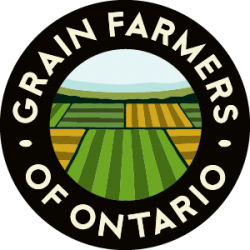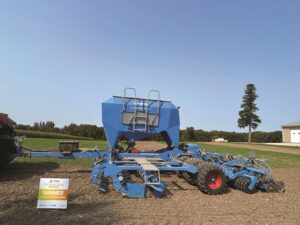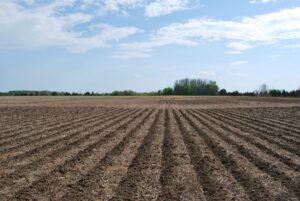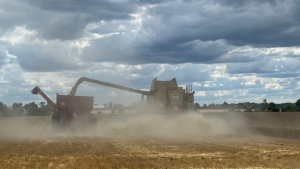What is carbon intensity?
Why does it matter for your grain farm?
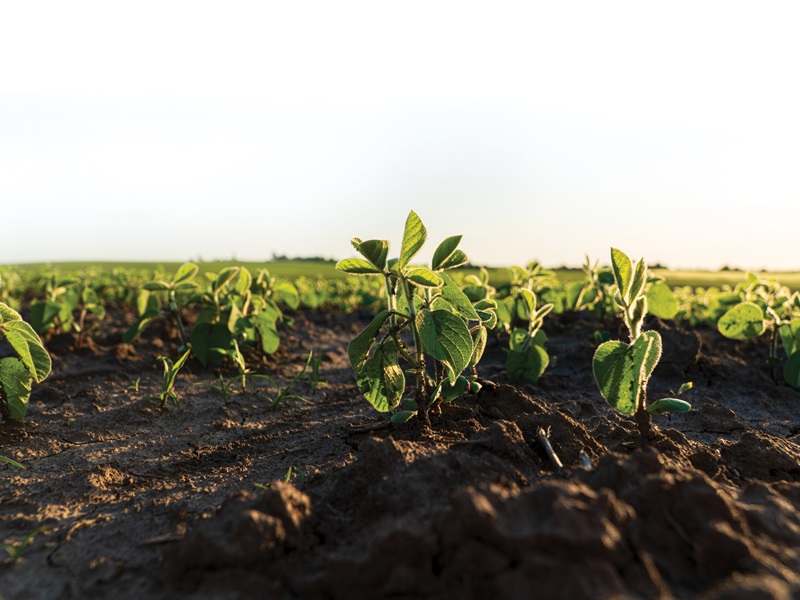
You might be hearing more talk about “carbon intensity” or “CI scores” lately, especially in relation to biofuels and sustainability initiatives. While it sounds technical, understanding carbon intensity is becoming increasingly relevant for Ontario grain farmers navigating new market demands and environmental considerations. So, what exactly is it?
WHAT IS CARBON INTENSITY (CI)?
Think of Carbon Intensity (CI) as the greenhouse gas (GHG) footprint associated with producing one unit of a specific product. For grain farmers, this usually means the total GHG emissions linked to growing one bushel of corn, soybeans, or wheat or producing one megajoule (MJ) of energy if that grain becomes biofuel.
The CI score is the specific number that quantifies this intensity. It’s typically measured in grams of carbon dioxide equivalent per megajoule of energy (gCO2e/MJ) for fuels or sometimes adapted to a per-bushel basis for grain. A lower CI score is better, indicating lower GHG emissions associated with production. A score of zero implies carbon neutrality for that unit of production.
HOW IS A CI SCORE CALCULATED?
Calculating a CI score isn’t just about one factor; it involves a lifecycle assessment. This means looking at the GHG emissions generated (and potentially carbon sequestered) across various stages:
Inputs: includes emissions from manufacturing inputs like nitrogen fertilizer (which is very energy-intensive to produce), pesticides, and seeds.
Field operations: fuel used for tillage, planting, spraying, and harvesting; emissions from the soil (like nitrous oxide from fertilizer application); changes in soil organic carbon due to tillage or cover cropping.
Transportation: moving inputs to the farm and grain from the farm.
(Potentially) processing: emissions associated with drying grain or processing it into other products (though this is often calculated further down the value chain).
Sophisticated models are used for these calculations. In the U.S., the Greenhouse gases, Regulated Emissions, and Energy use in Technologies (GREET) model is frequently referenced. In Canada, the federal government uses its Fuel Life Cycle Assessment (LCA) model to support regulations like the Clean Fuel Regulations. Tools like the Ontario Ministry of Agriculture, Food and Agribusiness AgriSuite GHG Decision Support Tool can also help farmers estimate their farm’s overall GHG footprint, covering many of the same data points relevant to CI.
WHAT DRIVES YOUR FARM’S CI SCORE?
Several key farm management factors influence your grain’s potential CI score:
Yield: generally, higher yields lower the CI score per bushel, as fixed emissions are spread over more products. However, this assumes input efficiency is maintained or improved.
Nitrogen management: this is a major factor. Optimizing nitrogen use through the 4Rs (Right Source, Rate, Time, Place), using enhanced-efficiency fertilizers, or potentially crediting manure applications can significantly reduce energy use upstream and nitrous oxide emissions in the field, lowering the CI score.
Tillage practices: reducing tillage intensity (moving towards no- till) typically lowers the CI score by cutting fuel consumption and helping sequester more carbon in the soil.
Cover crops: planting cover crops can increase soil carbon sequestration and potentially reduce the need for synthetic nitrogen, both contributing to a lower CI score.
Fuel efficiency: using less diesel for field operations directly reduces CO2 emissions.
WHY PAY ATTENTION TO CI?
The focus on CI scores is primarily being driven by a few key areas:
Biofuel markets: this is the biggest driver right now. Canada’s Clean Fuel Regulations (CFR) require gasoline and diesel suppliers to gradually reduce the average carbon intensity of the fuel they sell in Canada (aiming for about 15 per cent reduction below 2016 levels by 2030). Fuel producers are increasingly seeking low-CI feedstocks like corn, soybeans, and canola to produce ethanol, biodiesel, and renewable diesel to meet these targets. In the future, we are likely also to see low CI grain demand for applications in sustainable aviation fuel (SAF). Similar incentives exist in the U.S. (e.g., the 45Z tax credit).
Potential premiums: grain with a demonstrably lower CI score may command a premium price from biofuel producers or other buyers looking to meet regulatory requirements or corporate sustainability goals. While this market is still developing and premiums aren’t guaranteed, it represents a potential future revenue stream tied directly to sustainable practices.
Supply chain sustainability (“Insetting”): beyond biofuels, food companies and other manufacturers are increasingly scrutinizing the environmental footprint of their entire supply chain (Scope 3 emissions). Knowing and reducing the CI of the raw agricultural commodities they purchase might become a factor in sourcing decisions. This focuses on reducing emissions within the value chain (insetting) rather than buying external offsets.
Farm management insights: even without selling into a CI-sensitive market, calculating your farm’s GHG footprint or CI can provide valuable insights into where your biggest emissions sources are, helping you target management changes effectively.
CI IN THE CANADIAN CONTEXT
Canada’s Clean Fuel Regulations (CFR) are the key piece of policy- making CI that is relevant here.
The goal: reduce the carbon intensity of liquid transportation fuels sold in Canada.
How it works: fuel suppliers must meet progressively lower average CI targets for their fuel pool each year. They can do this by improving their own processes, blending more low-CI biofuels, or purchasing compliance credits.
Impact on farmers: creates demand for Canadian-grown feedstocks (corn, canola, soy, wheat) that can be verified as having a lower CI.
Requirements: farmers supplying grain potentially destined for biofuel markets under the CFR may need to sign declarations confirming the crop was grown in Canada (meeting land use and biodiversity criteria) and provide representative GPS coordinates for the harvested area. Today, each crop (i.e. corn, canola, etc.) is assigned a generic CI based on regional practice and emissions averages, and farm-specific CIs are not being measured directly.
CI VS. CARBON CREDITS: WHAT’S THE DIFFERENCE?
It’s easy to confuse CI scores with carbon credits, but they are distinct.
Carbon intensity (CI) score: measures the GHG footprint per unit of product (e.g., per bushel). It’s embedded in the product itself. Value comes from potential market premiums for low-CI products, driven by regulations like the CFR or supply chain demand.
Carbon credits (offsets): represent a discrete quantity of verified GHG reduction or removal (e.g., one tonne of CO2e). These credits can often be sold separately on compliance or voluntary markets to entities looking to offset their own emissions. Generating credits usually requires adhering to specific protocols and often involves longer-term commitments for practices like soil carbon sequestration.
While related (the same practices often lower CI and can generate credits), the mechanisms and markets are different.
WHAT CAN YOU DO NOW?
Focus on fundamentals: implementing practices that improve nitrogen use efficiency (4Rs), build soil health (reduced tillage, cover crops), and boost yields efficiently are beneficial for your bottom line and resilience and also happen to lower your potential CI score.
Keep good records: detailed records on inputs (especially nitrogen fertilizer), yields, tillage, cover crops, and fuel use are crucial for any future CI calculation or verification.
Stay informed: If your grain buyer asks you to participate in a CI- related program, ensure you understand the terms, benefits and risks. Grain Farmers of Ontario regularly publishes information on environmental sustainability programs and regulations in the Ontario Grain Farmer magazine and on www.gfo.ca, which may be helpful.
Explore tools: familiarize yourself with resources like OMAFRA’s AgriSuite GHG tool to understand your farm’s emission profile. While this will not provide a precise, validated CI score, it will give you a starting point should specific market opportunities arise in the future.
Carbon intensity is an evolving metric in agriculture. While direct market premiums are still developing, the underlying drivers— particularly clean fuel policies and supply chain sustainability demands—suggest that understanding and managing your farm’s carbon footprint per unit of production will likely become increasingly important.
Ibrahim Mohammed, PhD, is Grain Farmers of Ontario’s sustainability and environment specialist. •

